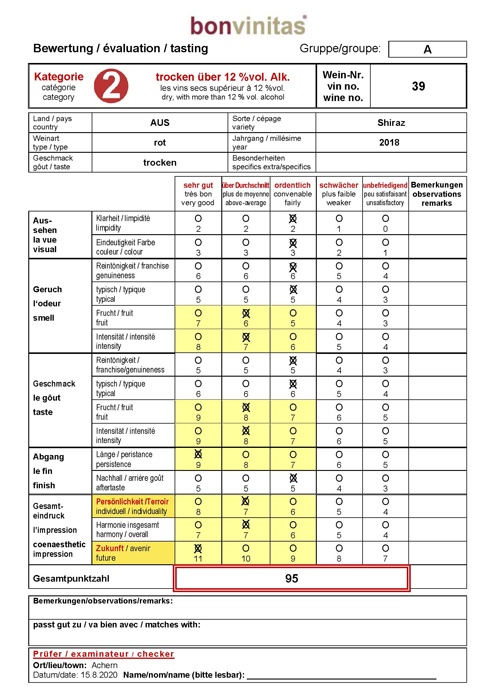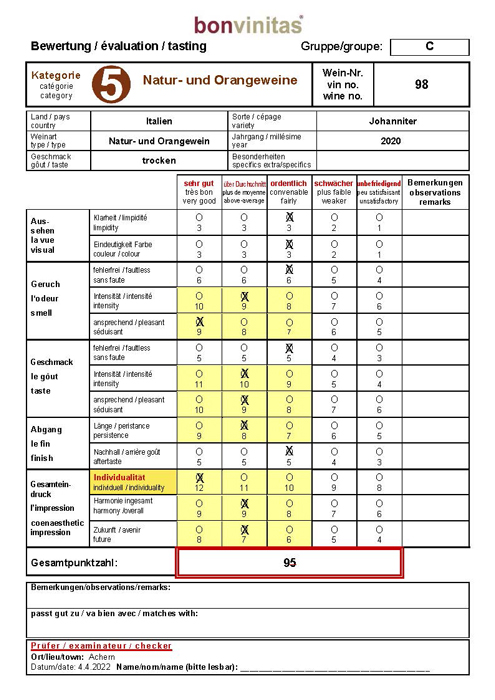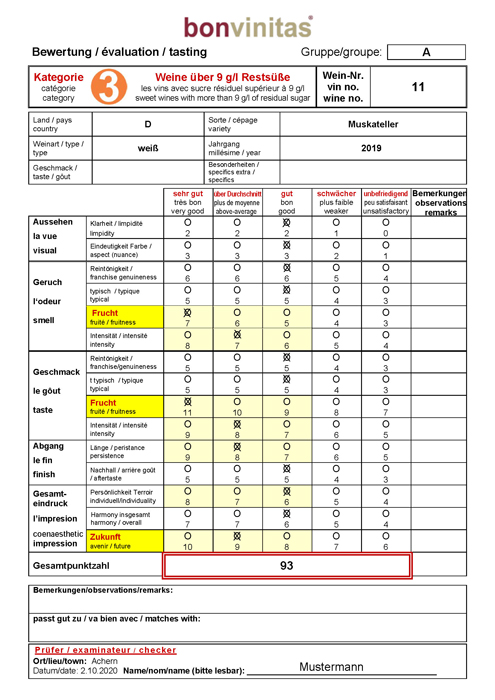The bonvinitas rating system
- The bonvinitas rarting system is used both, for the bonvinitas wine guide by groups of professionals and experienced wine lovers who evaluate in blind tests.
![]()
- And is used, too, by me, Dieter Simon, publisher of bonvinitas, for my personal reviews.
The bonvinitas 100-point system:
87 to 89 points: very good
90 and more - up to 94 points: excellent

Rating in five categories:
Category 1 - green points: lighter dry wines and sparkling wines up to 9 g / l residual sugar and up to 12% alcohol. Here we emphasize more on the freshness and liveliness in the bouquet and the drinking fun on the tongue. Because we are convinced that this is particularly sought after with lighter wines.
Category 2 - red points: dry wines and sparkling wines up to 9 g / l residual sugar but over 12% alscohol. Here we emphasize more the personality of the wine, the individual and terroir notes as well as the expected future, characteristics that are expected from these wines.
Category 3 - orange points: wines and sparkling wines with over 9 g / l residual sugar. Here we emphasize more the fruitiness as well as the probable future, because one expects first and foremost fruit from a sweeter wine.
Category 4 - purple dots, naturally sweet wines. Here we emphasize the fruit as in category 3, especially notes of tropical fruits.
Catagory 5 - earth-coloured points: natural and orange wines. Here we give more weight to the characteristics, the individual and substantial. See more below.
Absolut blind tasting - look our rating forms
Absolutely neutral blind tastings by wine experts are a matter of course, even from bonvinitas itself nobody evaluates. In the form's head, the examiners are only told: the country—without sub-area, the variety(s) only if it is on the label. Then the consumer may expect a varietal character to which the wine must correspond. We also name the wine' type that does not always reveals by looking, e.g. a Blanc de Noir. The vintage is mentioned when it is on the label. The same applies to taste information, such as "dry", because the consumer then may expect this. And the same also applies to special features such as “barrique”. If it is on the label, we name it to the tester because the wine then has to comply with. So much for the form’s header.
 Look an evaluation sheet’s example for a tester in category 1, in which we emphasize freshness, liveliness and drinking fun.
Look an evaluation sheet’s example for a tester in category 1, in which we emphasize freshness, liveliness and drinking fun.
First are assessed the appearance, then smell and taste as well as harmony and the overall impression. If the clarity and uniqueness of the colour are right, the wine receives 2 or rather 3 points. A wine cannot be clearer than clear and the colour not more typical than typical. As a result, the points do not increase beyond well. However, there are deductions if something is wrong. The same applies to the cleanliness and the typical smell of the variety. But the smell differs with its intensity, which can be good, very good or top class, as well as the impression of the nose over all.
What many appreciate in a lighter wine in the bouquet is freshness and liveliness. Therefore these weight more and can be evaluated in jumps up—marked yellow. This allows the wine to reach higher point regions. Because a good lighter wine is expected to be fresh, lively and stimulating on the nose. For this he should be graded well.
In terms of taste, the same applies. First of all if a wine is pure and clean it cannot be more pure and more typical of the variety than typical. Only if something is wrong are there deductions. More weight is given to drinking fun, which is particularly sought after and appreciated with lighter wines. We let this one score double jumps—marked in yellow.
Why shouldn’t a harmonious nice drop of good quality achieve 90 points or more just because it is lighter? Many wine lovers are looking for that. We don’t think the thicker the better, but the wine has to be right in its kind. Always three or more neutral examiners evaluate in a group, each one on his own. The results are then averaged. This is how the points that can be found in our wine guide are created.
 category 2 wines with over 12% alcohol—these are above all the higher qualities (red points). As the example shows, we are weighting personality and terroir character in jumps up. As well we weight a good future higher—each marked in yellow. We think that there are a lot of decent wines, but what makes a wine special and estimable is its individual like terroir tones and the future. Here, too, look an example of an evaluation sheet in category 2.
category 2 wines with over 12% alcohol—these are above all the higher qualities (red points). As the example shows, we are weighting personality and terroir character in jumps up. As well we weight a good future higher—each marked in yellow. We think that there are a lot of decent wines, but what makes a wine special and estimable is its individual like terroir tones and the future. Here, too, look an example of an evaluation sheet in category 2.In category 3, wines with over 9 g / liter of residual sugar, we rate the fruitiness in two leaps, because this is what people are looking for, as well as the future. The same
As you can see, we have developed a very good rating system which, in addition to thick and heavy, also gives lighter and residual sweet wines good opportunities and underlines their character, because not only are the tastes different, but also the drinking occasions.applies to category 4, naturally sweet wines. Sample reviews can be found here.
The evaluation sheets in the category 5 has to be a little different. Why please see below.
As to the category 5 - natural and orange wines
 These represent something special and must be evaluated somewhat differently, because:
These represent something special and must be evaluated somewhat differently, because:
Natural and orange wines are produced by means of mash fermentation, partial mash fermentation and also by Maceration Carbonique. In principle, they are absolute low-impact wines without must clarification, spontaneously fermented without the addition of yeast. In any case, sulfur doses are greatly reduced or often completely omitted.
The resulting oxidation processes result in orange to amber white wines in which the primary aromas of the variety are not in the foreground, but rather secondary and tertiary aromas such as tea, spices, beeswax, roasted almonds... Wines of this type are naturally rich in tannins, full-bodied, complex and offer some surprises. Such wines may even be a little naturally cloudy.
Natural and orange wines are not offered massively, but are increasing significantly, especially in the organic PIWI scene.
Only truly blind tastings is our first commandment
Criteria No. 1:
No person employed by bonvinitas shall take part in the evaluating of wines, nor shall he or she influence the tasting in any way. Any such activity would be an absolute “no-go” in our eyes. The sole task of bonvinitas is to prepare and organize the tastings.
Criteria No. 2:
Evaluations shall be completed by independent sommeliers and other wine experts. bonvinitas always pays strict attention to the experts’ esteem and credentials.
Criteria No. 3:
The tasting is 100 % blind. Information such as producer or wine region shall not be disclosed to the tasters. Country of origin, grape variety and vintage are the only criteria given when the tasting takes place.
Criteria No. 4:
The evaluation shall be based on the well-established 100-points rating system. 80-90 points show a grade of “above average“ or „very good”. 90-95 points indicate an “outstanding” wine. Wines with 96 points and above are “extraordinary “.






